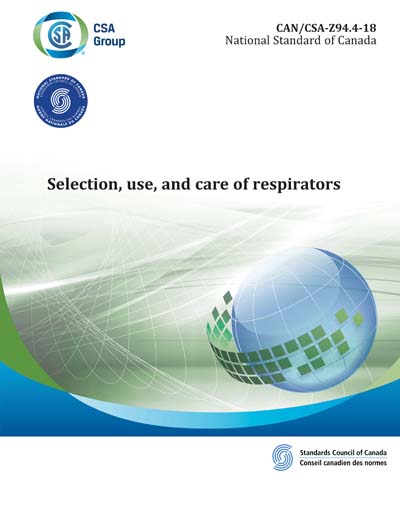Historical
CAN/CSA Z94.4-2018
Selection, use, and care of respirators
Preface This is the fifth edition of CAN/CSA-Z94.4, Selection, use, and care of respirators. It supersedes the previous editions published in 2011, 2002, 1993, and 1982. This Standard sets out requirements for the selection, use, and care of respirators and for the administration of an effective respiratory protection program in the workplace. Its purpose is to protect respirator users from any known or potential respiratory hazards. In 2017, CSA Group completed a research project that gathered evidence to verify the bioaerosol protection factors set out in this Standard as well as the control banding approach for selection of respiratory protection against infectious bioaerosols (Clause 7.3.4.3). This Standard is based on respirator classification schemes and testing requirements set out by the National Institute for Occupational Health and Safety (NIOSH). Specific criteria for firefighting applications are based on standards published by the National Fire Protection Association (NFPA). CSA Z180.1 is a companion Standard to CAN/CSA-Z94.4, providing specific requirements for compressed breathing air systems connected to supplied-air respirators. This Standard is also referenced by many other CSA Group occupational health and safety standards where respiratory protection is required (e.g., CSA W117.2 on welding safety, CSA Z1006 on work in confined spaces, CSA Z1010 on work in extreme conditions, CAN/CGSB/CSA-Z1610 on protection of first responders, and CSA Z1640 on PPE for entry into clandestine drug labs). A number of significant changes have been introduced in this edition of the Standard: a) Clarification has been made regarding the supervisor?s role in a respiratory protection program (Clause 5.3). b) Clause 6 has been re-ordered to clarify how hazard assessment and risk assessment are to be used as the basis for selection of appropriate respirators (especially in situations where both air contaminants and bioaerosols are present). c) Several clarifications have been provided regarding requirements for initial and subsequent periodic training (Clause 8.2.5). d) Additional guidance has been provided on the handling of respirator interference concerns (Clause 9.2). e) Clause 12, on health surveillance, has been modified to clarify the point that a health assessment is needed prior to fit testing and that there may be medical reasons for not subjecting an individual to a fit test. f) The wearer?s comfort has been made a significant factor in selection of respirators and fit testing (see Clause 14.4 and expanded Annexes B and C). g) Annex K, providing scenarios for bioaerosol exposure situations, has been significantly expanded. h) A new Annex (N) has been added to provide guidance on measurement of bioaerosols and determining exposure limits. i) A new Annex (O) has been added to provide information on the persistence of bacteria, fungi, viruses, and other pathogens on surfaces and in air. j) A new Annex (Q) has been added to provide guidance on accommodation of individuals having special needs. k) A new Annex (R) has been added to provide further guidance on the records required to be maintained for both qualitative and quantitative fit testing (Clause 14.4). This Standard has been developed in compliance with Standards Council of Canada requirements for National Standards of Canada. It has been published as a National Standard of Canada by CSA Group. Scope 1.1 This Standard sets out requirements for the selection, use, and care of respirators and for the administration of an effective respiratory protection program in the workplace. 1.2 This Standard is applicable to the selection, use, and care of respirators for non-emergency and emergency situations. 1.3 This Standard is not intended to address the selection of a) respirators for aircraft oxygen systems; b) supplied-air suits; or c) respirators for protection against radiological contaminants. This Standard applies to all other aspects of a respiratory protection program for these respirators. 1.4 This Standard is not intended to address a) underwater breathing devices (see CSA Z275.2); b) requirements for protection for first responders during CBRN (chemical, biological, radiological, and nuclear) events (see CAN/CGSB/CSA-Z1610); or c) inhalators and resuscitators. 1.5 The values given in SI units are the units of record for the purposes of this Standard. The values given in parentheses are for information and comparison only. 1.6 In this Standard, "shall" is used to express a requirement, i.e., a provision that the user is obliged to satisfy in order to comply with the Standard; "should" is used to express a recommendation or that which is advised but not required; and "may" is used to express an option or that which is permissible within the limits of the Standard. Notes accompanying clauses do not include requirements or alternative requirements; the purpose of a note accompanying a clause is to separate from the text explanatory or informative material. Notes to tables and figures are considered part of the table or figure and may be written as requirements. Annexes are designated normative (mandatory) or informative (non-mandatory) to define their application.
Content Provider
CSA America, Inc. [csa]






